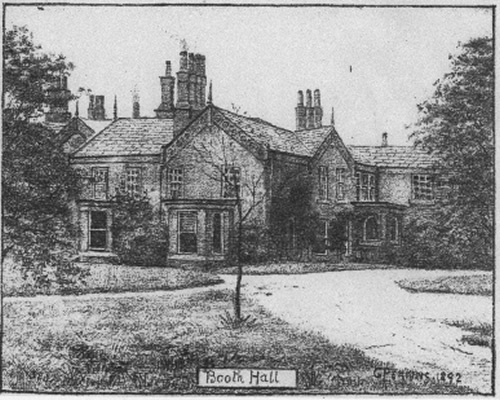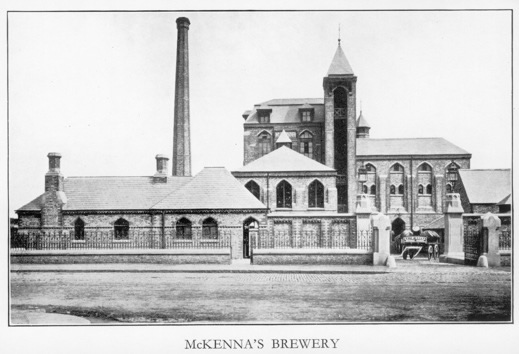2nd & 3rd Generations
2nd & 3rd Generations
Returning to the story of the McKennas, Bernard, senior, died in Manchester in 1847, aged 71, and his wife took over the licence of the Briton’s Protection, certainly until 1856.14Around this time her two sons, now in their late twenties/early thirties, created the partnership, B & J McKenna, and began their business acquisitions.
After 18 busy years at the Briton’s Protection, the business-minded McKennas had built up sufficient capital and knowledge of the industry to expand their pub portfolio. They had acquired the George & Dragon by 1856 and by 1863 had also purchased The Wellington, 97 Rochdale Road, later to be rebuilt by them in 1888 to designs by theatre architects Darbyshire & Smith15 and subsequently renamed The Marble Arch which remains (2019) one of the most distinctive of Manchester’s public houses. The brothers also acquired The Balloon public-house, also on Rochdale Road. Other pub acquisitions would follow.
Their purchase of the George & Dragon may have been motivated by anticipated increased trade at the pub following the expansion of the nearby Smithfield Market, roofed over with four vast arcades of cast iron and glass in 1853-4, and construction of the Smithfield Market Hall on Swan Street in 1857/8 (The ‘Mayor Mackie Building’ just 50 yards from Band on the Wall). The move of the markets to the Smithfield site had begun in 1820 and originally operated as ‘a largely open space with rows of curved shambles in one corner and a piazza along the southern edge’16.
Bernard, junior, took the licence of the George & Dragon from 1856, though he never lived there. In his late 30s, he was now married and by 1861 he and his wife Mary Ann (38), from Chester, Cheshire, had moved from the McKenna family home of the Briton’s Protection to the semi-rural setting of Booth Cottage, close to Boggart Hole Clough, in the grounds of Booth Hall, Blackley, less than three miles from the George & Dragon.
Continuing the tradition of the McKenna family forenames, Bernard’s and Mary Ann’s two sons were named Bernard and John, then (1861) aged six and one respectively. Towards the end of the century, these two brothers would take the reins of the family business, which thus remained ‘B & J McKenna’. We can speculate that the childhood environment of the two young McKenna boys, and their elder sister Mary, may have verged on the idyllic: at Booth Cottage, in the large grounds of Booth Hall, surrounded by various small farms. Their parents now had four live-in servants, including a 17-year-old stable boy from County Kilkenny, Ireland, and a groom.

At the time of the 1861 Census the elderly matriarch Ellen McKenna continued to live at the Briton’s Protection but the younger son John, now in his mid thirties, had taken the licence. He was now married to Esther (30) and for a time they also lived at the pub with their daughter Eleanor, then aged six, and one servant/waiter and two house servants.
In 1863, Bernard was listed17as trading as wine and spirit merchant at the George & Dragon that had two addresses, 25 Swan Street and 23 or 25 Oak Street. Some light is thrown on the variety of addresses for the George & Dragon in Chapter 4, The Buildings. Bernard is also listed in the trade directory for 1863 at The Wellington, 97 Rochdale Road, and at his former home, the Briton’s Protection where his brother John is also listed.
Now with at least four pubs in the McKenna portfolio – The Briton’s Protection, The Wellington, The Balloon and The George & Dragon – trade must have been good as in the 1860s the McKennas took their next big step in the expansion of their business: They built the imposing Harpurhey Brewery, Rochdale Road, employing the Salford building firm of Gregory & Haynes.18 In addition to brewing there…
“A large part of the McKenna’s trade was in wines and spirits. Wines were bought in bulk and bottled on the premises and they also blended their own whisky, imported from Scottish and Irish distilleries” – (Gall, above)

The brewery, less than a mile from the McKennas’ Blackley home, was described as ‘an architectural ornament to Harpurhey’ and erected ‘at great expense, the object of the proprietors being to exemplify the various processes of the brewing industry upon the most improved and scientific principles’.19 Though the brewery ‘had a very prosperous career from the first,’ in the 20th century it was no longer owned by the McKennas and it ceased operations and was converted into smaller commercial units.20
‘Although nothing of the brewery is still standing, it is remembered in the names of two roads flanking the old site – Bernard Street and Brewster Street (once Brewery Street).’(Gall, above)






